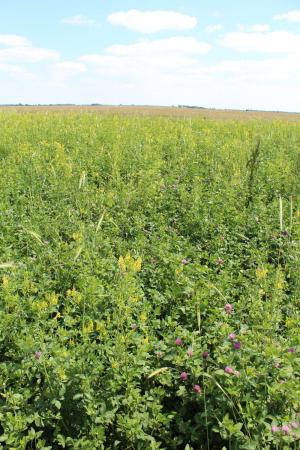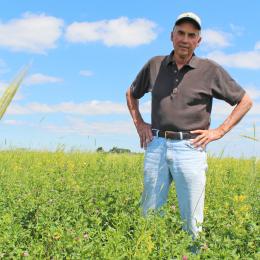Jack Erisman went all in organic and now spreads the word about conservation and cover crops.
Old Ideas, Good Ideas
- Christian & Shelby Counties, Illinois
- Acres: 2,000
- Crops: Food grade organic crops & seed
- Planting: Conservation-Till
- Covers: Cereal Ryegrass, Hairy Vetch for seed, medium Red Clover, Sweet Clover, & Orchard Grass
Jack Erisman farms 2,000 acres of farmland in Christian and Shelby Counties. He’s been farming since 1963. Erisman is all about sustainability, ecological issues, and socially acceptable farming techniques. He has found a way to achieve all this and be profitable. His most important tool? Cover crops.
Jack spoke at a recent meeting where conservationists met to discuss issues and techniques for managing cover crops in Illinois. He asks the group a question: “How have we fed ourselves for 7,000 years without synthesized inputs? We’ve tapped into the synergies offered in nature. That’s what it takes.
Jack went cold turkey in 1990 on 2,000 acres, all in. He went organic. His operations have always included livestock because they permit more diversity and opportunity. Jack describes his fast-track transition to organic as ‘challenging.’

But even today, Jack admits he is always learning something new. “When I think back, I can honestly say I don’t ever remember NOT having cover crops. If you had a bad field, you planted sweet clover on it and let it mature into the second year. Problem solved.”
Those words are becoming more and more true as producers across Illinois—and the nation--re-engage the use of forage and cover crops to improve the health of soil and reinvest in their farm’s greatest asset: the soil. Jack is glad to see interest and use of cover crops coming back. “They’re back, but they’re back with even better science behind them.”
When speaking to producers, Jack advises, “When you do cover crops, you will always learn something new. I’ve been doing this so long and I can say that with respect to cover crops, I’ve had it all happen to me at one point or another. I’ve done it right and I’ve done it wrong. I’ve tried a lot of different scenarios and I’m still learning and making adjustments.”
Jack’s Christian County operation is located in Central Illinois between Pana and Assumption. Here he farms on Virden, Herrick, and Oconee soils predominately. On the Shelbyville Moraine, where his home farm is located, it's not uncommon to find five or six mapped soil types in a 30- or 40-acre field.

He grows food grade crops and seed—all organic. Crops include blue corn, specialty beans, and cereal crops and he grazes grass-fed beef. He rotates grass/legume pastures which he uses to finish cattle prior to sale.
Jack sites cereal rye as being the most versatile of all the cover crops he’s tried but can also be a problem if not properly managed. He has raised hairy vetch for seed, as well as medium red clover, sweet clover, and orchard grass.
When it comes to cover crop mixes, Jack advises farmers to pick their variety or mix of seed very carefully. In a drought, Erisman believes cover crops can truly give you an advantage. “Believe me, there are more advantages than disadvantages. But either way, it’s an education!”
The USDA’s Natural Resources Conservation Service (NRCS) stands behind Erisman and supports all options producers take to build up the quality of their soils. State Conservationist Ivan Dozier announced a national agency effort to help farmers unlock the secrets of the soil. He says NRCS offers conservation programs as well as technical and profiles in soil health Jack Erisman financial assistance to help producers do this across the state. Although cover crops are challenging and they require a higher level of management, Erisman urges growers not to shy away from the complexities because the benefits are worth it.
“I believe the real issue is that most row crop farmers are ruled by a sense of urgency, by impatience. I manage a more holistic system. It requires a different perspective, a different timeline, and a completely different approach. That’s the biggest change, the biggest barrier. The bottom line? Cover crops offer a way to find true sustainability and real cost savings. That is for certain,” Erisman explains.
To learn more about cover crops and other soil building techniques for your farm operation, contact your local NRCS office or visit the Illinois NRCS website.

“The mixes can be a lot to manage but they can offer unbelievable benefits and improvements to your soil”

